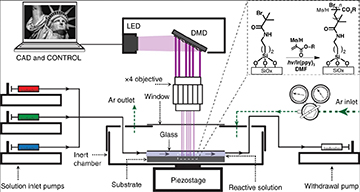![]()
Researchers at CCNY and Northwestern University have developed a nanoscale 4D-printing technique that uses fluorescent polymer brush patterns to photochemically print intricate patterns. They demonstrated the system by creating a tiny nanoprinted replica of Oliver Kuehl’s photograph “Lady Liberty.” [Image: CUNY Advanced Science Research Center]
Inspired by a 33-year-old treatise on nanotechnology, a research team from City University of New York (CUNY) and Northwestern University, USA, has developed a light-driven technique to build surfaces that can begin to reflect the complexity of living tissue (Nat. Commun., doi: 10.1038/s41467-020-14990-x).
Dubbed polymer brush hypersurface photolithography, the technique combines off-the-shelf 3D-printing technology with build-arounds devised by the team, says group leader Adam Braunschweig of CUNY’s Advanced Science Research Center. The result, he says, is a photochemical tool for creating surfaces from polymer brush patterns, wherein more than three properties in each volume element, or voxel, of the pattern—position along the x and y axes, polymer height, and chemical composition along the polymer chain—can be independently controlled.
Control without photomasks
The term hypersurface borrows from mathematics to indicate a structure for which more than three variables are independently varied; in the team’s setup, all of these are controlled by light, without the need for expensive photomasks. The result, according to Braunschweig, is a surface that can support many applications, including high-throughput drug research, biosensor development, non-adhesive films, and optics. “It is a versatile, powerful platform for doing chemistry on surfaces,” he says.
Braunschweig credits ideas in the 1987 book “Engines of Creation: The Coming Era of Nanotechnology” by K. Eric Drexler, for the challenge his team embraced to “start building at the nanoscale with soft materials.” Considered one of the founding fathers of nanotechnology, Drexler promoted the idea of precision in biomolecular manufacturing.
A printer, plus
Schematic of the team’s experimental setup. [Image: C. Carbonell et al., Nat. Commun. 11, 1244 (2020); CC BY 4.0] [Enlarge image]
The CUNY/Northwestern U. team’s equipment setup includes a Terraprint E series 3D printer, which features an LED light directed toward a digital micromirror device (DMD) containing 750,000 micromirrors, each 10 microns in size and representing one pixel. A CPU controls the mirrors to collimate light through a lens and on through a window to solution in a home-built reaction chamber, inducing a photochemical reaction. Microfluidics introduce monomer solutions into the airtight reaction chamber, which sits atop a piezoelectric stage.
“The height of the polymer is controlled by light dosage, gathering monomer from solution,” Braunschweig explains. “We can dynamically control the solution as the polymer chain grows toward the light so the structure of the growing chain can be controlled in real time,” he says. The system thus forms a platform for the photochemical patterning of block copolymer arrays in which the position and composition of each of 750,000 pixels can be independently controlled, with micrometer scale resolution in x and y, and nanometer control in z.
“The integration of microfluidics and an air-free reaction chamber with the DMD is the key innovation that allows the spatiotemporally controlled grafting of different materials onto the substrate,” the authors write in the paper. In principal, they say, it could be used to make polymer patterns from an unlimited number of unique brush compositions.
Shrinking Lady Liberty
As a proof of concept, Braunschweig and his team re-created an image of “Lady Liberty” by photographer Oliver Kuehl (see opening image, above) as well as an image of the Barcelona, Spain, skyline by artist Ana Maria Edulescu. For both images, fluorescent polymer brushes were created from initiators on the substrate, and the gradations in color, or color densities, correspond to differences in polymer heights—all controlled by light from the DMD.
“A picture is worth a thousand words,” Braunschweig says of the proof-of-concept images. He says Lady Liberty was chosen for many reasons but especially because “she represents a lot of beautiful ideas.”
Building optical films
Another example for an application, Braunschweig says, would be an optimized film for an optical material—perhaps a lens. The film would need to have several salient properties depending on its intended use or purpose. In more traditional manufacturing, each property would have to be created and layered independently. With the new surface patterning technology, all properties could be created on the film in one massively parallel operation.
“Making and characterizing films is a lengthy process,” Braunschweig says. “Here on a single surface, we can examine hundreds of thousands of variables.”
In fact, in Braunschweig’s view, the most unappreciated application in many fields is the need for delicate but precise surfaces and films to carry out other functions. He believes that the new patterning technology could remove a huge bottleneck for scientific discovery. “This will accelerate discovery in surface chemistry,” he says.

